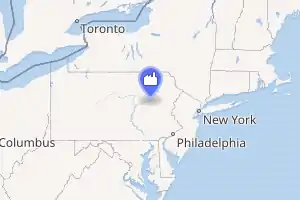Bell Bend Nuclear Power Plant
The Bell Bend Nuclear Power Plant was[1][2][3] a proposed nuclear power plant, which would have been built on the Bell Bend of the Susquehanna River in Luzerne County, Pennsylvania adjacent to the Susquehanna Steam Electric Station.[4]
| Bell Bend Nuclear Power Plant (proposed, cancelled) | |
|---|---|

| |
| Country | United States |
| Location | Salem Township, Luzerne County, Pennsylvania |
| Coordinates | 41°5′N 76°9′W |
| Status | Cancelled |
| Operator(s) | PP&L |
| Nuclear power station | |
| Reactor type | PWR |
| Reactor supplier | AREVA |
| Power generation | |
| Units cancelled | 1 × 1600 MW US EPR |
On October 10, 2008, PPL Bell Bend, LLC, a subsidiary of PPL submitted a Combined Construction and Operating License application (COL) for the plant with the Nuclear Regulatory Commission (NRC)[5] — in time for the potential plant to qualify for production tax credits under the U.S. Energy Policy Act of 2005.[6]
The proposed nuclear power plant consisted of one European Pressurized Reactor (EPR) steam electric system designed by the French company AREVA. The rated core thermal power would be 4,590 MWt. The rated and design net electrical output was approximately 1,600 MWe.[7] Plants using this technology were reportedly in 2008 under construction in Finland, France, and China.[8] The plant would be built by PPL and UniStar Nuclear Energy, a joint enterprise of Constellation and French energy giant EDF.
PPL spokesman Dan McCarthy said in 2008 that the plant would cost about $10 billion to develop, and seven to eight years to construct — beginning operation in 2016 or 2017.[8] A 2011 estimate gave costs as $13–15 billion and an operational starting date of 2018-20.[4] PPL filed an initial application for federal loan guarantees by the September 29, 2008 deadline.[9] PPL intended to submit the second part of the application by the December 19 deadline.[8] PPL Chief Operating Officer William Spence said, "Without federal loan guarantees, companies like PPL will not be able to secure financing for the substantial cost of building new, advanced-design nuclear energy plants that will help this country achieve challenging limits on carbon dioxide emissions, as well as energy independence".[10]
The license application was withdrawn on August 31, 2016.[1]
Notes
- "Talen Energy Withdraws Bell Bend License Application". talenenergy.investorroom.com. August 31, 2016. Retrieved 2017-06-04.
- https://www.nrc.gov/reactors/new-reactors/col/bell-bend.html
- "Talen Energy Withdraws Bell Bend Nuclear License Application". 2016-08-31.
- https://web.archive.org/web/20110707222948/http://www.bellbend.com/faqs.htm retrieved 2011-01-24
- "APPLICATION FOR COMBINED LICENSE FOR THE BELL BEND NUCLEAR POWER PLANT" (PDF). Nuclear Regulatory Commission. 10 October 2008. Retrieved 2011-07-19.
- "Bell Bend Nuclear Power Plant". UniStar Nuclear Energy. Retrieved 2008-10-08.
- "Bell Bend Nuclear Power Plant Environmental Report" (PDF). Nuclear Regulatory Commission. Retrieved 2011-07-19.
- Tim Mekeel (1 October 2008). "PPL Works For Option To Build Nuke Plant". Intelligencer Journal. Retrieved 2008-10-08.
- "Areva and others beat loan guarantee deadline". World Nuclear News. 30 September 2008. Archived from the original on 9 October 2008. Retrieved 2008-10-08.
- "PPL seeks federal loan guarantee to help construct nuclear power plant". LehighValleyLive.com. September 30, 2008. Retrieved 2008-10-08.